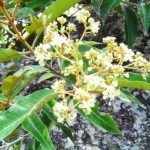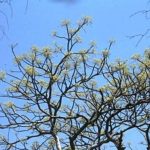TREE LIFE
July 1999
If there is a red face on your label, it is a reminder that your subs ($80) for 1999/2000 have not been received and this will be the last issue of Tree Life that we can send you.
MASHONALAND CALENDAR
Saturday 3 July. Botanic Garden Walk. On this Botanic Garden Walk Tom will continue with that interesting family of plants – EUPHORBIACEAE, which began on the June walk. We will meet Tom in the car park at 10.45 for 11 a.m. There will be a guard for the cars.
Sunday 18 July. Ruzawi School, which is our venue in the Marondera area, is a first for many of us. This is a very scenic area, and the vegetation is a little similar to that of Gosho Park. We will meet there at 10 a.m.
Saturday 24 July. Mark’s June Walk was cancelled so we will keep that venue which is to the Greystone Park Nature Reserve. we meet at 2.30 p.m.
Saturday 7 August. Botanic Garden Walk.
Wednesday 11 August to Sunday 15 August. This is over the public holiday weekend and a trip has been arranged to visit the Vumba. Because accommodation is booked in a private house the size of the group will be limited. Your place will be reserved on a first come basis. Phone Maureen for information and reservations.
MATABELELAND CALENDAR
Sunday 4 July. To Mtshabezi Dam in the southern Matopos. All day trip. Phone Jonathan, Anthon, or Tessa to confirm. Meet at Girls’ College car park (Pauling Road entrance) for 8.30 a.m. sharp departure. This trip will include the AGM for the Matabeleland Branch, including voting in the Committee.
Sunday 1 August. Possible trip to Leopard Rock Nature Reserve, near Khami Dam on the outskirts of Bulawayo.
BOTANIC GARDEN WALK: SATURDAY 5th JULY 1999
The subject today was part 1 of the Euphorbiaceae. This is a huge, diverse family, including large trees, cactus-like succulents, shrubs, perennial herbs and even tiny annuals. Perhaps the main botanical distinguishing feature is the unisexual flowers; so members of the family may be monoecious (male and female flowers on same plant) or dioecious (male and female flowers on different plants).
A number of other features also occur in the family but exceptions to all of these do occur and these include:
alternate leaves
simple leaves
stipules generally present (but mostly fall off quickly)
fruits often 3-lobed
milky latex (surprisingly few, although species of the genus Euphorbia itself do)
stellate hairs
The separation of genera depends generally on minute botanical details within the very small flowers and in particular, whether the sepals are imbricate or not, whether there are petals or not, the shape of the disk, whether the male flowers have a non-functioning ovary or not, and the number of ovules in each loculus, which are not easy characters.
Our first port of call was Antidesma venosum, the tassel-berry. This has red berries in pendulous spikes, which are attractive to birds. It occurs frequently along low and medium-altitude rivers.
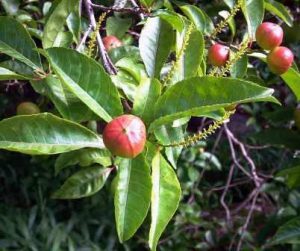
Excoecaria bussei. Photo: Rob Burrett. Source: Flora of Zimbabwe
Next we looked at the pawnbroker tree, Excoecaria bussei. This is one that does have milky latex. The leaves are alternate, glossy and have a markedly serrate margin. It also has large 3-Iobed fruits, each lobe of which contains a spherical brown seed. Tom explained that it occurs along dry river courses (not really in riverine vegetation) and in dry forest such as Jesse; it occurs generally at low altitudes. Later, in the forest section, we saw the amazingly glossy leaves of Excoecaria madagascariensis. This is very rare in Zimbabwe, occurring only in the understorey of Chirinda. Like Excoecaria bussei, it also produces milk, but it remarkably within the same genus, has opposite leaves. The leaves are strikingly glossy.
Phyllanthus reticulatus produces the familiar potato smell of lowveld rivers in the evening! The feeling was that it was the flowers that produce the smell, although a number of people did not think it was like potatoes but was a distinctive smell in its own right. As with many other species of Phyllanthus, the arrangement of the simple leaves with the deciduous branchlets resembles pinnate leaves.
In the forest area, we later saw Phyllanthus inflatus, whose leaves look even more like compound leaves, but as they bear both flowers and fruits they must be stems and not the rachis of a compound leaf. This is a rare Eastern Districts tree occurring in the Chirinda Forest. The fruits are 3-locular.
Later, we saw Phyllanthus engleri. This is a rather local species at low altitudes in N Zimbabwe, occurring, for example at Hippo Pools by the Umfurudzi or by the road between Mt Darwin and Rushinga. It is called the spurred Phyllanthus and indeed a principal feature is spiny clusters of old sterns and leaves on the stems.
A rather rare tree is Tannodia swynnertonii. This is a very tall species (to 30 m) in the Chirinda Forest and Tom has seen it elsewhere, for example in the Burma Valley. The leaves are shiny and alternate with a prominent drip-tip and a long petiole. Another feature we noticed was the distinctive domatia on the under surface. The flowers occur in long spikes.
Nearby was the rare understorey shrub, Argomuellera macrophylla. It occurs frequently in the Chirinda Forest, attaining 2 or exceptionally 3 meters. The leaves are large and serrate white the inflorescence consists of apical flower spikes with flowers clustered along the spikes. Tom mentioned that it has lovely yellow stamens that are quite showy.
On next to the great Croton sylvaticus/ Macaranga mellifera question. The Croton is known as the Mount Selinda linden; it is a common forest tree and rather unusually is deciduous. The fruits are 3-locular and the seed orange and as Tom demonstrated the slash is greenish-yellow with a peppery smell.
Macaranga mellifera is a common pioneer forest tree. In my view, this is not always easy to tell from the Croton, but given a leaf and a lens, one can see that Macaranga has golden glands all over the lower leaf surface whereas the Croton has no glands but indeed has stellate hairs.
Macaranga capensis has larger leaves than mellifera, which are peltate (although only just). It too has golden glands all over the underside of the leaf. Another feature is the spines on the lower parts of the branches.
Another pair of species we were able to compare was the two Suregada. Suregada procera occurs in forest understorey. Tom showed us that the leaf blade is undulate, not level and another feature is that the blade is decurrent on the stem. Just appearing were the flowers in fascicles. Later, we were able to compare this with Suregada zanzibariensis, which has a rugose upper surface and bright orange seeds. This species is rare, occurring in dry Newtonia forests.
All in all, it was a great opportunity to learn more about some of the rare Euphorbiaceae in Zimbabwe and our thanks as usual go to Tom.
-Mark Hyde
CROTON MEGALOBOTRYS AND SOME OF THE PROPERTIES OF THE GENUS
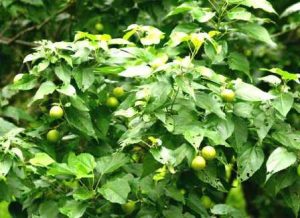
Croton megalobotrys. Photo: Bart Wursten. Source: Flora of Zimbabwe
In Tree Life 231, whilst talking about the oil properties of Jatropha curcas, Andy MacNaughtan raised the question about the anti-malarial usage of Croton megalobotrys. Some years ago now I noticed the seeds of Croton megalobotrys being fed to Mourning Dove chicks in the Zambezi Valley, and mindful of the comments in Coates Palgrave, looked into the properties of this plant. I should also add that at that time I collected a good handful of the seeds from the area in order to get average measurements of the seeds since I thought they were rather mega! to be fed to the chicks, but alas, a squirrel or two raided that stock! So the interesting thing about this is that both birds and squirrels (to name a few), with their different digestive systems, are able to deal with the seeds without ill effect. However, here are some notes on the genus, not all referring to anti-malarial properties.
Cascarilla
This is a West Indian shrub Croton eluteria whose bitter aromatic bark is used as a tonic. The name derives from Spanish, a diminutive of cáscara which name refers to cascara sagrada, the bark of Rhamnus purshiana of NW North America, used as a laxative and stimulant.
Cascarilla is the dried bark of Croton eluteria containing not less than 1.5% v/w of volatile oil. Store in a cool dry place.
An aromatic bitter usually administered as an infusion (1 in 20 of boiling water: dose: 15-30 ml) or tincture (1 in 5: dose: 2-4 ml).
Cascarilla is also used in fumigating compounds on account of its aromatic odour while burning. p.617.
Croton Oil
Oleum Crotonis: Oleum Tiglii
Dose: 0.03 – 0.06 ml (½ to 1 minim). An oil expressed from the seeds of Croton tiglium. It is an amber-yellow, orange or brown viscous liquid with a nauseous odour and taste, which is at first mild but afterwards sharp and acrid. Wt. per ml about 0.95 g.
Insoluble in water: soluble in 1 in less than 1 of dehydrated alcohol forming a clear solution but the addition of more alcohol causes separation in two layers; freely soluble in carbon disulphide, chloroform, ether, light petroleum, & fixed and volatile oils. Exposure to air and light causes darkening & increases the viscosity of the oil and its solubility in alcohol. Protect from light & air in small well-fitted containers.
Toxic effects and Antidotes
As for Colocynth, i.e.: Severe abdominal pain, vomiting, and diarrhoea with bloodstained watery stools, delirium and prostration. A dose of from 4-6 g may be fatal. The powdered drug causes severe pain if it comes into contact with the nasal mucous membranes.
Antidotes: The stomach should be emptied by emetics or by lavage with dilute tannic acid solution and the patient kept warm. Opium tincture should be given by mouth or rectum, or morphine injected subcutaneously, followed by stimulants & demulcent drinks. Maintain hydration by fluids orally or intravenously.
Contra-indications: It should not be given to children, pregnant women or feeble subjects & is contra-indicated in the presence of haemorrhoids & inflammatory conditions of the stomach and intestines.
Uses
Croton oil is so violent a purgative that it is now rarely employed: it has been used in very severe constipation. Externally, it is a powerful counter-irritant & vesicant. pp. 1271-1272.
CROTON MEGALOBOTRYS (GUBOGA)
The bitter bark is used by the natives of the Transvaal and Portuguese East Africa as a malaria remedy. At one time it was popular among Europeans for the same purpose, the seed being used as well as bark. The powdered bark is usually made into pills & is said to produce benefit, but opium may be an ingredient. In Gazaland and in the Eastern Transvaal the bark has been used as a fish poison. Both the seed and bark produce emesis and purgation in the dog and diarrhoea in the rabbit. Chewing the seed produces a burning sensation in the throat and mouth. In the human the bark and seed produce, in addition to these effects, salivation, slight nausea and slight purgation. These effects are thought to be due to the presence of an acrid principle. The Shangaan take the seed as a drastic purgative. The juice expressed from 225 gm of the fruit has no ill effect in a rabbit. The bark has a slight but not unpleasant odour and the dust from it produces sneezing, with a burning sensation in the throat and on the tongue. The bark contains 0.21-0.41% of a crystalline proline derivative 4-hydroxyhygric acid C16H11O3N.H2O mp 242° which appears to be irritant and to cause numbness on tasting, though the results were obtained from an impure principle. The timber is a useful white wood. The seed yields 29.6% of oil, representing 49.8% of the moisture-free kernels. This golden-yellow semi-drying oil has a nutty odour. The Luvale administer an infusion of the root to thin babies to make them fat.
Well, so much for Croton megalobotrys. I have never tried any of these ‘remedies’ but I have tested the effects from chewing on a leaf! (Put it down to the effects of the hot Zambezi sun). If any unhinged readers want to try I advise just a few nibbles along the midrib, don’t try and eat/chew the whole leaf. You are likely to experience a fairly mild burning sensation in the throat and then the feeling of a sore throat, as from a cold sans all the nasty impacts of that affliction, but without actually having a sore throat. It’s quite interesting and wears off after a short while with no other side effects having been felt.
-Ian Riddell
ALBIDA, THE TREE FOR ALL SEASONS
Better one albida in your field than three sons in the family. OLD HAUSA PROVERB
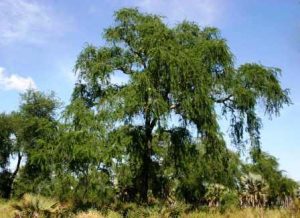
Faidherbia albida. Photo: Bart Wursten. Source: Flora of Zimbabwe
Acacia albida was named in 1813, but it was always an anomaly in the genus Acacia and was eventually renamed Faidherbia albida in 1934, although it was not until the 1980s that the new name gained wide acceptance.
It is one of the largest of all African “acacias”, reaching heights of 30 metres and bole diameters up to 1.5 metres. It is widely distributed in the African continent, from Egypt, Sudan, Ethiopia, and Somalia in the east and to Senegal and Gambia in the west. It extends southwards across the whole width of Africa to its southern limit in northern Natal, South Africa. Outside of Africa, it occurs in Yemen, Palestine, Israel, and Lebanon. Most commentators believe that the acacia of the Bible – the shittim (wood) or shittah (tree) – refers to Acacia seyal, but at least one Israeli botanist and Bible commentator holds that the species in question was, in fact, Faidherbia albida. He argues that only albida was tall enough to provide the long lengths required for the framework of the Tabernacle, especially for the central bar, which would have been about 15 metres long (Exodus 36:21-33). He cites some of the rabbinic writings to support his belief, and further argues that the acacia wood was actually brought from Egypt among the possessions of the Israelites at the Exodus (Exodus 35; 22-24).
In Zimbabwe albida is a species of the alluvial banks of the lowveld rivers of the Zambezi and Save-Limpopo systems, and perhaps it is best known from the Mana Pools area. It also occurs near Bulawayo, and along the border with Botswana. The English names for Faidherbia albida are ‘apple-ring acacia’, from the curled shape of the seed pods which are reminiscent of dried apple rings; ‘whitethorn’, from the white bark of the young branches; ‘winterthorn’ from the growth characteristic that sets it apart from most African trees – full leaf in winter and leaflessness in summer; or simply ‘albida‘, from the tree’s specific epithet. Other vernacular names in Zimbabwe are ‘mutsangu’ (Shona), ‘umpumbu’ (Ndebele), and ‘hlofungu’ or ‘mukalaunga (Shangaan).
A number of differing theories have been put forward to explain the phenomenon of the seasonally inverted foliage cycle in albida. One of these suggests that rising river levels in the rainy season temporarily “drown” the tree’s root system, causing defoliation and a seasonal inactivity equivalent to hibernation. Whatever the real reason for the phenomenon, the species is certainly subject to partial submersion by flooding rivers in most years, but there are many examples of leafless individuals standing alongside others in full leaf. In West Africa albida is not confined to river banks, and specimens are often found a long way from rivers, but even in those situations, where root “drowning” cannot possibly occur, the species still exhibits the seasonally inverted cycle. An example of this may be seen in albida planted in the National Botanic Garden in Harare.
Albida has an almost revered place in the economies of peasant farmers in West Africa, particularly in Senegal and northern Nigeria, but most of all in Niger where ferocious laws at one time prescribed beheading for felling an albida, and the loss of an arm for lopping a branch!
The species’ leaflessness during the summer months permits crops to be grown beneath the trees without loss of light; the dormant state of the trees removes competition for nutrients and moisture; and leaf fall at the beginning of the rains provides the under-sown crops with an excellent natural fertilizer. The leaf litter is said to decompose rapidly and to provide a large quantity of nitrogen for the soil beneath the trees, and agriculturists have reported higher yields of cereal beneath albida than away from them. The seedpods are rich in protein, and are relished by domestic stock and game animals.
Albida is in every way an ideal tree for peasant farms, but appreciation of its merits has been slow in coming to Zimbabwe and southern Africa in general. This is partly because of its restricted habitat along the banks of lowveld rivers, and partly because there is not the same age-old tradition of planting and preserving trees in southern Africa as there is further north. Perhaps there may be significance in the fact that the agricultural merits of albida gained earlier recognition in those countries that had a long history of Arab influence. Traditional uses of albida in Zimbabwe appear to have been limited to two only. Infusions of the bark have been widely used to treat stomach disorders, and along the Zambezi River the boles of large trees have been used to make dugout canoes. However, agriculturists and foresters have begun to examine the possibilities of introducing the species into the agricultural economy of the communal lands in the form of farm forestry – the so-called agroforestry. Trials have been established with seed collected from most of the species’ sub-Saharan range, and in due course these will determine the seed sources that are the most suitable for Zimbabwe’s general conditions.
-Lyn Mullin.
THE TREE OF TÉNÉRÉ
The Tree of Ténéré – L’Arbre du Ténéré – must be (or was? See below) the loneliest and most isolated tree on earth. Reputedly, there isn’t another tree within about 50 km!
It is famous as the only tree (?) to feature on a road map such as those for the Sahara and associated areas, e.g. as in the old Michelin maps popular with overland travellers and the like. However, the maps featuring the tree date back more than a decade and I haven’t seen a recent one to see if it still features – which is why this note is written assuming it’s still extant!
Agades sits on the trans-Sahara road south of the Aïr Mountains, and if you set out from there, heading east and northeast to Bilma, 555 km distant, after some 250 km of arduous travelling you may be lucky enough to find the tree. Standing in the Erg du Ténéré, the Ténéré Desert, in more-or-less central Niger, in an area pretty close to the Sahel, explains why there is any vegetation there at all. The Tree must have been established in centuries past when the area was wetter and there is, or was, a well near the Tree with bad water at about 40m, no great feat for a desert tree to tap from. But with the desertification of the Sahel, which has been sped up by an extended drought between the late 1960s and early 1980s, the worst in 150 years, perhaps the region is being reclaimed by the inexorably shifting sands and is firmly on the way to becoming a true erg!
I have tried to source references to the Tree is order to ascertain its species, being fairly certain that it is an Acacia of some sort, but have had no luck. I was also anxious to clarify whether it is still alive! I did run into an ex-National Parks ecologist who seemed to remember a paper re the tree but she thought the purpose of the paper was to notify the lonely tree’s demise … most unfortunate if true. Does anyone out there know anything more about it?
–Ian Riddell
ANDY MACNAUGHTAN CHAIRMAN


